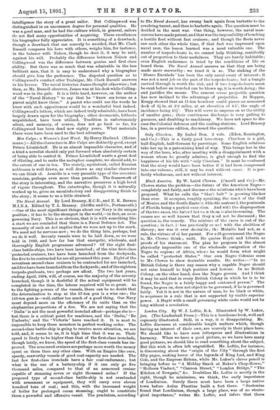The Naval Annual. By Lord Brassey, K.C.B., and E. K.
Barnes, 11.I.N.A. Edited by T. A. Brassey. (Griffin and Co., Portsmouth.) —One of the most significant things about our Navy is its unique position ; it has to be the strongest in the world,—in fact, an over- powering Navy. This is so obvious, that it is with something like a start we are reminded that there is a Naval Defence Act. The necessity of such an Act implies that we were not up to the mark. We need not be nervous now; we do the thing late, perhaps, but we do it well. Seventy vessels were to be laid down, so we were told in 1889, and how far has that energetic, wholesale, and thoroughly English programme advanced ? Of the eight first- class battle-ships, two have been launched ; of the nine first-class 'protected cruisers, two have been launched from the dockyards, the five to be contracted for are all promised this year. Eight of the seventeen second-class cruisers to be contracted for are launched, and five have been launched from the dockyards; and of the eighteen torpedo-gunboats, two perhaps are afloat. The two last years, ending April, 1894, will, of course, see the majority of the seventy launched, though it is doubtful if the actual equipment will be -completed in the time, the labour required will be so great. As to the fighting powers of the vessels, there can be no doubt that the determination to stop at the 67-ton gun is a wise one ; the 110-ton gun is—well, rather too much of a good thing. Our Navy must depend more on the efficiency of its units than on the elephantine proportions of a few. We are not saying that the Italia' is not the most powerful ironclad afloat—perhaps she is—
but there is a critical point for machines, and the 'Italia,' 'Re Umberto,' and the 'Victoria' have reached it. It is next to impossible to keep these monsters in perfect working order. The second-class battle-ship is going to receive more attention, we are told, and, it seems to us, it is high time that it was so. Their speed is likely to be higher than that of the first-class ironclads, though lately, we know, the speed of the first-class vessels has im- proved. The armoured cruisers are perhaps more worth the money spent on them than any other class. With an Empire like ours, speedy, seaworthy vessels of good coal-capacity are needed. The last few first-class ironclads have a fair coal-endurance ; but what is the use of a battery-ship if it can only go five thousand miles, compared to that of an armoured cruiser capable of steaming seven or eight thousand miles ? If the proposed type of second-class battle-ship is not overloaded with armament or equipment, they will carry over eleven hundred tons of coal ; and this, with the increased weight of boiler for prolonged ocean steaming, ought to constitute them a powerful and offensive vessel. The pendulum, according
to The Naval Annual, has swung back again from barbette to the revolving turret, and then to barbette again. The question must be decided in the next war. One thing, however, the naval man- ceuvres have made patent, and that was the impossibility of touching a hostile fleet without fast cruisers ; and though the fleets never saw each other the whole time, if that fact was impressed upon naval men, the lesson learned was a most valuable one. The number of torpedo-boats is, we cannot help thinking, manifestly out of proportion to their usefulness. They are barely habitable ; even English endurance is tried by the conditions of life on board them. The Naval Annual assures us that they are being made more seaworthy : we trust it is so. The sinking of the 'Blanco Encalada ' has been the only naval event of interest ; it was not a neat job on the part of the torpedo-boats ; but a bungle carried through is worth the risk, and if two torpedo-boats must be sunk before an ironclad can be blown up, it is worth doing ; the end justifies the means. The armour versus projectile question has now inclined to the advantage of projectiles. At Meppen, Krupp showed that an 11-ton howitzer could pierce an armoured deck of 3i in. at 2.2 miles, at an elevation of 45°, the angle of incidence being 464°. This will serve to impress on us the utility of smaller guns ; their continuous discharge is very galling to gunners, and disabling to machinery. We have not space to dis- cuss the Colonial defences and the coaling stations. Lord Brassey has, in a previous edition, discussed the question.


































 Previous page
Previous page